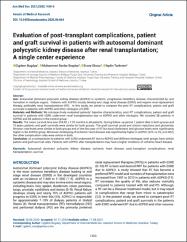| dc.contributor.author | Buğday, Çiğdem | |
| dc.contributor.author | Buğday, Muhammet Serdar | |
| dc.contributor.author | Öksüz, Ersoy | |
| dc.contributor.author | Türkmen, Aydın | |
| dc.date.accessioned | 2022-03-10T12:51:55Z | |
| dc.date.available | 2022-03-10T12:51:55Z | |
| dc.date.issued | 2021-08-17 | en_US |
| dc.identifier.citation | Bugday, C., Bugday, M. S., Oksuz, E., & Turkmen, A. (2021). Evaluation of post-transplant complications, patient and graft survival in patients with autosomal dominant polycystic kidney disease after renal transplantation; A single center experience. Annals of Medical Research, 28(8), 1450-1456. | en_US |
| dc.identifier.uri | https://www.annalsmedres.org/index.php/aomr/article/view/3867 | |
| dc.identifier.uri | https://hdl.handle.net/20.500.12899/586 | |
| dc.description.abstract | AbstractAim: Autosomal dominant polycystic kidney disease (ADPKD) is systemic, progressive hereditary disease, characterized by cyst formation in multiple organs. Patients with ADPKD mostly develop end stage renal disease (ESRD) and require renal replacement therapy, preferably renal transplantation (RT). In this study, we aimed to compare the post-RT complications, patient and graft survivals in patients with ADPKD and other etiologies of ESRD. Materials and Methods: We retrospectively evaluated patients’ baseline characteristics, post-RT complications, patient and graft survival in patients with ESRD underwent renal transplantation due to ADPKD and other etiologies. We included 28 patients in ADPKD and 28 patients in the control group. Results: The mean survival time was 224.83 ± 7.53 months in all patients. During follow-up period 1 patient died in both groups and 10 years patients and graft survivals were similar for both groups. The graft survival, acute and chronic rejections and glomerular filtration rate levels were similar in both groups end of the first year of RT but total cholesterol and glucose levels were significantly higher in the ADPKD group. Moreover, developing of ischemic heart disease was significantly higher in ADPKD (32% vs 0%, p=0.002), the other complication rates were similar in both. Conclusion: As a comparesion to patients with ESRD underwent RT due to ADPKD and different etiologies, both groups have similar patient and graft survival rates. Patients with ADPKD after transplantation may have a higher incidence of ischemic heart disease. | en_US |
| dc.language.iso | en | en_US |
| dc.relation.ispartof | Annals of Medical Research | en_US |
| dc.rights | info:eu-repo/semantics/openAccess | en_US |
| dc.subject | Autosomal Dominant Policyctic Kidney Disease | en_US |
| dc.subject | Ischemic Heart Disease | en_US |
| dc.subject | Survival | en_US |
| dc.subject | Renal Transplantation; | en_US |
| dc.subject | Post-transplant Complications | en_US |
| dc.title | Evaluation of post-transplant complications, patient and graft survival in patients with autosomal dominant polycystic kidney disease after renal transplantation; A single center experience | en_US |
| dc.type | Article | en_US |
| dc.authorid | 0000-0002-8088-1009 | en_US |
| dc.authorid | 0000-0002-3745-1302 | en_US |
| dc.department | MTÖ Üniversitesi, Tıp Fakültesi, Dahili Tıp Bilimleri Bölümü | en_US |
| dc.institutionauthor | Buğday, Muhammet Serdar | |
| dc.institutionauthor | Öksüz, Ersoy | |
| dc.identifier.doi | 10.5455/annalsmedres.2020.06.664 | |
| dc.identifier.volume | 28 | en_US |
| dc.identifier.issue | 8 | en_US |
| dc.identifier.startpage | 1450 | en_US |
| dc.identifier.endpage | 1456 | en_US |
| dc.relation.publicationcategory | Makale - Uluslararası - Editör Denetimli Dergi | en_US |
| dc.indekslendigikaynak | TR-Dizin | en_US |


















